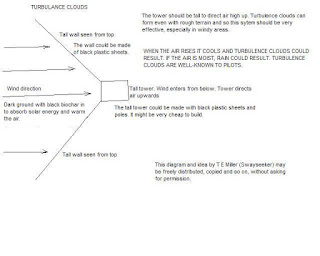Air pollution solution calculations : Many people do not realise that there is a sufficient amount of solar energy to heat massive volumes of air every day. The problem is getting air to come into intimate contact with hot surfaces. The ground heats air immediately above it, but there is not intimate contact with large volumes of air. Solar air heaters provide large hot surface areas and intimate contact. See
http://www.builditsolar.com/Experimental/PopCanVsScreen/PopCanVsScreen.htm
Often about 7 kWh of solar energy fall on every square metre of surface in a day. This is 7x3600 kJ, which is 25200 kJ of energy. Air has a volumetric heat capacity of about 1.2 kJ/(deg C.cubic metre) and we might ask how many cubic metres of air we could heat by 5 deg C every day with the 25200 kJ? The answer is we can heat 25200/(5x1.2) cubic metres by 5 deg C in a day. We divided by 1.2 (volumetric heat capacity) and by 5 (the number of degrees the air is heated.). This is 4200 cubic metres that can be heated 5 deg C in a day by a 1 square metre solar air heater.This has great implications for diluting air pollution, for enhancing chances of convectional rain and for cooling cities. If we place a large number of solar air heaters above each other on a tall pole we could have massive heating of air.
If the solar elevation angle is not 90 degrees, then we can do this without the one solar air heater casting a shadow on the one below. Only at midday, in equatorial regions, on two days a year, could we have a solar elevation angle of 90 degrees, so we can safely say it is possible not to have shadows cast on solar air heaters below, for the most part of the day and year, anyway.
Another advantage of this is that we could cool cities like Kuwait city. Huge solar air heaters on the tall pole would shade parts of the city, the solar energy would go into heating the air, the air would rise and transfer heat to a higher altitude and Kuwait city would be cooler.
I had a hard time finding figures for the volumetric heat capacity of air. In fact I could not find a table so I made one.The figures will be useful for calculating how many cubic metres of air at a certain temperature and pressure of 101.325 kPa can be heated by a solar air heater, for example.
I calculated the figures using Specific heat of mixture of gases=sum of (mass fraction x specific heat of each gas). I then calculated the mass of a cubic metre of air with RH=50% for various temperatures and multiplied specific heat by mass of a cubic metre of air with RH=50 and P=101.325 kPa at various temperatures. The RH makes very little difference to the volumetric heat capacity (although it does make a bigger difference to the specific heat in kJ/kg.degC.). For instance the volumetric heat capacity of dry air at 35 deg C at P=101.325 kPa=1.154 kJ/degC.m^3 and the volumetric heat capacity for an RH=50% parcel at the same temperature and pressure is 1.159 kJ/degC.m^3.
The chart is for people living in cities on the coast. If you want a chart for your city, please give me altitude. If you want to do calculations on air pollution and convection then you can proceed as follows:
1) Find out how many kWh you receive in a day from Weatherspark Note that this Weatherspark figure is for a horizontal surface. If you let the solar air heaters face the sun you could get a lot more kWh of heat.
2) Decide on the area of your solar air heater and multiply (eg 100 sq metres and 6 kWh per sq metre per day. kWh=6x100=600 kWh. This is 600x3600 kJ (1 kWh=3600 kJ) ie this is 2160000kJ).
3) If you heat the air 5 deg C, then number of cubic metres heated in a day by 5 deg C = 2160000/(5xvolumetric heat capacity). You can get the volumetric heat capacity from the chart.
4) If the system is only 70% efficient, then multiply by 70/100=0.7.









